Railroad Industry Outlook: Economy Boom to Retain the Upside
Railroad fortunes are contingent on coal as revenues from the commodity contribute significantly to the respective companies’ top line. Despite President Donald Trump’s pro-coal stance, the industry does not seem to have revived much. U.S. coal production registered 180.8 million tons in the second quarter of 2018, down 3.7% sequentially and 3.4% year over year. This was reportedly the third straight quarter decline.
Moreover, per U.S. Energy Information Administration (EIA), coal production is expected to slip 1% and 2% year over year in 2018 and 2019, respectively. This downside is primarily due to a drop in U.S. coal exports and a fall in usage of coal in electricity generation across the United States.
However, the thriving U.S. economy is highly beneficial to growth of railroads as a buoyant domestic economy generally results in an uptick in rail shipments of goods across the United States. The improved scenario is evident from U.S. gross domestic product’s (GDP) record growth of 4.2% (almost double the first-quarter figure) during the second quarter of 2018, an all-time high in nearly four years. Economic growth and demand for freight are positively correlated. With high freight demand, the industry clearly stands to gain.
Another key source of revenues, intermodal, has improved by leaps and bounds this year. Second-quarter intermodal volumes rose 6.2% year over year and 4% sequentially. Also first-quarter intermodal volumes climbed 7.2% from the year-ago quarter’s tally. Strong intermodal volumes have been boosting railroads’ top line and the uptrend is likely to continue going forward.
Apart from these macroeconomic fundamentals, the railroad players’ sustained cost-reduction efforts are anticipated to drive the bottom line going forward.
Industry Outperformance vs. Sector & S&P
Rising freight demand as well as strong volume growth seems to have boosted investor confidence in the space. Consequently, the Zacks Rail Industry has outperformed both the S&P 500 index and the broader Zacks Transportation Sector over the past year.
While stocks in the industry have collectively surged 31%, the Zacks S&P 500 Composite and Zacks Transportation Sector have rallied 15.8% and 6.3%, respectively.
One-Year Price Performance
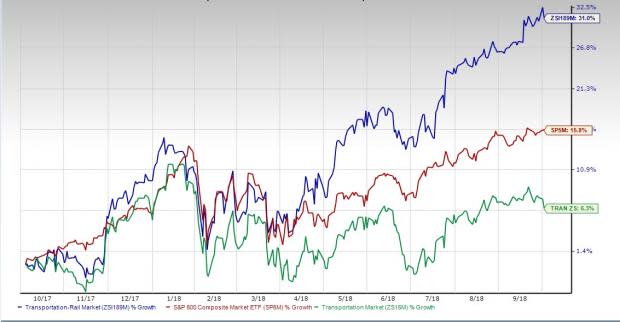
Railroad Stocks Pretty Expensive
Owing to the industry’s outperformance with respect to its sector and the S&P 500 index in a year, the valuation looks quite expensive. Railroad companies are often valued using the price-to-book (P/B) ratio due to large variations in their earnings results from one quarter to the next.
The industry currently has a trailing 12-month P/B ratio of 5.15, above its lowest level of 3.72 and near the median and the highest level of 4.31 and 5.17 respectively, in a year’s time.
The space is also quite overpriced when compared with the market at large as the trailing 12-month P/B ratio for the S&P 500 index is 4.11 and the median level is 3.86.
Price-to-Book Ratio
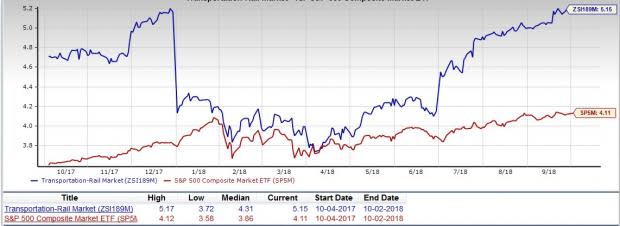
However, given the varied components of the S&P 500 index, a comparison with the group’s own sector makes better sense. A comparison with the group’s broader sector also shows that the industry is currently trading at a premium. The transportation sector’s trailing 12-month P/B ratio of 3.46 and the median level of 3.38 for the same period are significantly lower than the rail industry’s respective ratios.
Price-to-Book Ratio

Outperformance May Continue on Solid Earnings Outlook
The railroads have been making relentless efforts to achieve record low operating ratios (operating expenses as a percentage of revenues) in order to boost profits. Railroad majors like Union Pacific Corp. (UNP) and CSX Corp. (CSX) aim at achieving an operating ratio of 60% by 2020 while Norfolk Southern Corp. (NSC) targets an operating ratio of below 65% by 2020 or even earlier. To this end, railroads’ shift to a Precision Scheduled Railroading model is a notable move.
The model reduces costs, enhances services and leads to optimal asset utilization. CSX adopted the model last year and has generated efficiency-related savings to the tune of $460 million in the period. Meanwhile, Union Pacific recently announced a new operating plan incorporating principles from the model. Benefits from the plan, effective Oct 1, are anticipated to aid the company in achieving its target operating ratio by 2020 and thus, pave the way for an operating ratio of 55%.
Moreover, the financial prosperity of companies in the industry is evident from its key players announcing dividend hikes this year. Notably, Norfolk Southern raised its dividend by a total of 29% so far this year following two hikes. Also, Union Pacific announced a dividend hike to the tune of 10% this July, the third hike since November 2017.
But what really matters to investors is whether this group has potential to perform better than the broader market in the quarters ahead. The earlier valuation discussion shows that market participants have been willing to pay up for these stocks, potentially limiting further upside from the current levels.
One reliable measure that can help investors understand the industry’s price performance prospects is its earnings outlook. Empirical research shows that earnings outlook for the industry, a reflection of the earnings revisions trend for the constituent companies, has a direct bearing on its stock market performance.
The Price & Consensus chart for the industry shows the market's evolving bottom-up earnings expectations for it and the industry's aggregate stock market performance. The red line in the chart represents the Zacks measure of consensus earnings expectations for 2019 while the light blue line represents the same for 2018.
Price and Consensus: Zacks Railroad Industry
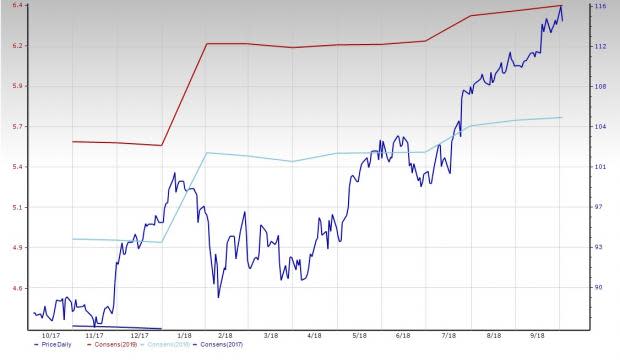
This becomes even clearer by focusing on the aggregate EPS revisions trend. The chart below shows the evolution of aggregate consensus expectations for 2018.
Please note that the industry’s $5.72 EPS estimate for 2018 is not the actual bottom-up EPS estimate for every company in the Zacks Railroad industry but rather an illustrative aggregate number created by our proprietary analytics model. The key factor to keep in mind is not the earnings per share of the industry for 2018 but how this estimate has evolved recently.
Current Fiscal Year EPS Estimate Revisions

As you can see here, the EPS estimate for 2018 is up from $5.44 at the end of March and has been rising ever since. In other words, the sell-side analysts covering the companies in the Zacks Railroad industry have been steadily raising their estimates.
Zacks Industry Rank Indicates Bright Prospects
The group’s Zacks Industry Rank is basically the average of the Zacks Rank of all the member stocks.
The Zacks Railroad industry currently carries a Zacks Industry Rank #91, which places it at the top 36% of more than 250 Zacks industries. Our research shows that the top 50% of the Zacks-ranked industries outperforms the bottom 50% by a factor of more than 2 to 1.
Moreover, our proprietary Heat Map shows that the industry’s rank was consistently in the top 50% over the past eight weeks.

Railroad Stocks Promise Long-Term Growth
When compared with the broader Zacks S&P 500 Composite, the long-term (3-5 years) EPS growth estimate for the Zacks Rail industry appears alluring. The group’s mean estimate for long-term EPS growth rate has been increasing since the beginning of the ongoing year to reach the current level of 11.5%. This compares favorably with the Zacks S&P 500 Composite’s reading of 9.8%.
Mean Estimate of Long-Term EPS Growth Rate

In fact, the basis of this long-term EPS growth could be a steady top-line rise that the Zacks Rail industry has shown since the beginning of 2017.

Bottom Line
The railroad industry seems to be on a solid footing not just in the near term but in the long haul as well, banking on robust freight demand on the back of a buoyant economy. The Fed forecasts GDP to rise 2.8% this year. Additionally, it expects the same to increase 2.4% and 2% in 2019 and 2020, respectively. The upbeat projections will most certainly spur higher freight demand and strengthen railroads’ top line in the process.
With this bullish backdrop in place, it would be prudent for investors to make the most of the situation and invest in some top-ranked railroad stocks that have been witnessing positive estimate revisions for the current year.
Each of the stocks mentioned below carries a Zacks Rank #2 (Buy). You can see the complete list of today’s Zacks #1 Rank (Strong Buy) stocks here.
3 Top Picks
CSX is one of the leading transportation suppliers in the United States. The Zacks Consensus Estimate for current-year earnings has been revised 1.4% upward over the past 60 days. Shares of the company have rallied more than 44% in a year.
Price and Consensus: CSX
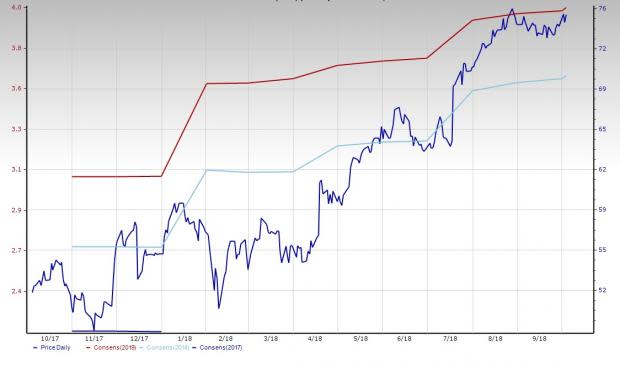
Union Pacific provides rail transportation services across 23 states in the United States through its principal operating company, Union Pacific Railroad Company. The Zacks Consensus Estimate for 2018 earnings has moved 0.4% north in 60 days. Shares of the company have gained more than 43% in a year’s time.
Price and Consensus: UNP
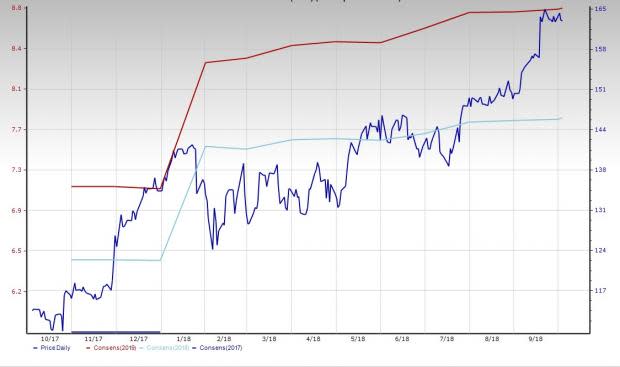
Canadian Pacific Railway Limited (CP) operates a transcontinental railway network in Canada and the United States. The Zacks Consensus Estimate for current-year earnings has been raised 0.9% over the past 60 days. The stock has jumped more than 26% over the past year.
Price and Consensus: CP
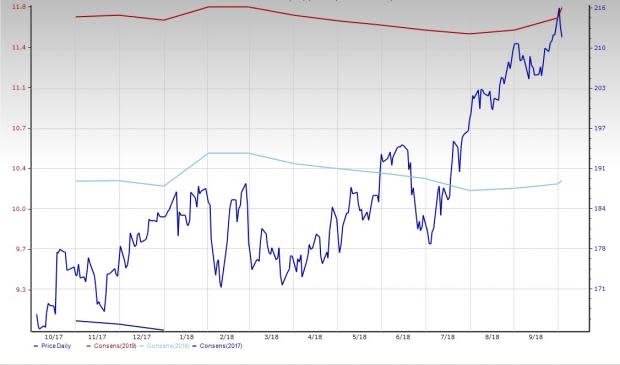
5 Companies Verge on Apple-Like Run
Did you miss Apple's 9X stock explosion after they launched their iPhone in 2007? Now 2018 looks to be a pivotal year to get in on another emerging technology expected to rock the market. Demand could soar from almost nothing to $42 billion by 2025.
Reports suggest it could save 10 million lives per decade which could in turn save $200 billion in U.S. healthcare costs. A bonus Zacks Special Report names this breakthrough and the 5 best stocks to exploit it. Like Apple in 2007, these companies are already strong and coiling for potential mega-gains.
Click to see them right now >>
Want the latest recommendations from Zacks Investment Research? Today, you can download 7 Best Stocks for the Next 30 Days. Click to get this free report
Union Pacific Corporation (UNP) : Free Stock Analysis Report
Norfolk Southern Corporation (NSC) : Free Stock Analysis Report
CSX Corporation (CSX) : Free Stock Analysis Report
Canadian Pacific Railway Limited (CP) : Free Stock Analysis Report
To read this article on Zacks.com click here.
Zacks Investment Research

 Yahoo Finance
Yahoo Finance 









